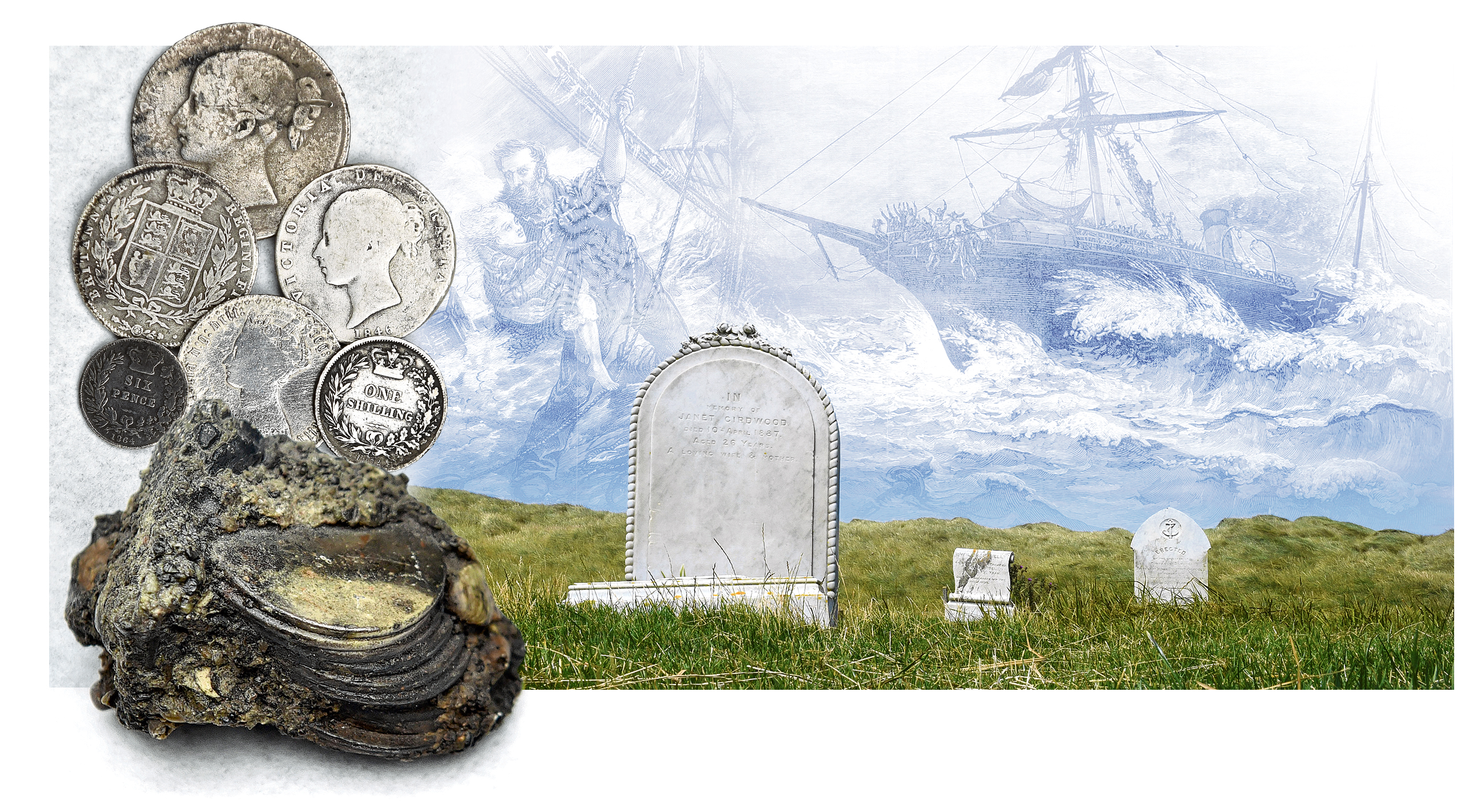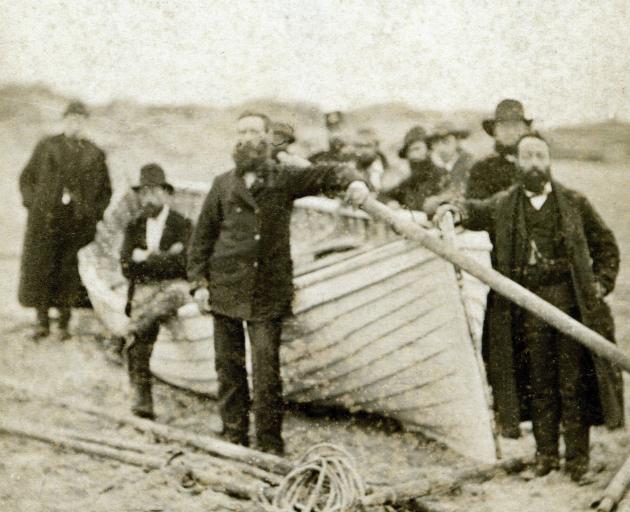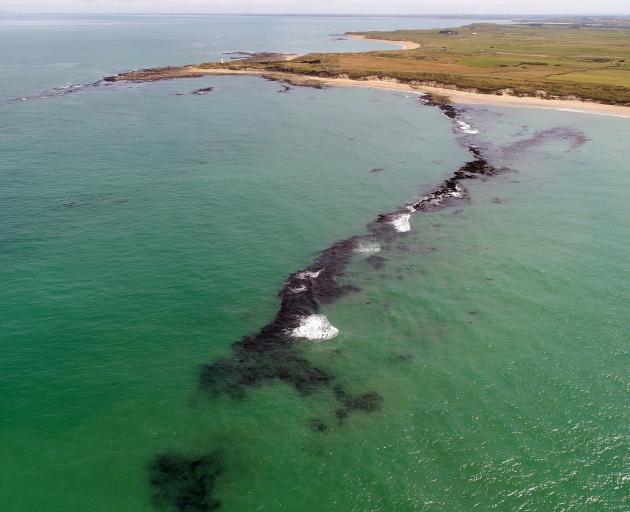

The southeastern tip of the South Island is exposed to prevailing stormy westerlies that can howl through Foveaux Strait, making sea-going rough and treacherous.
But occasionally, and more often during winter, a wind can blow from the northwest, leaving the waters around this headland calm and clear.
It was like that on the morning more than three decades ago that Ross, from Balclutha, and half a dozen fellow underwater enthusiasts from across Otago and Southland, donned diving gear to search for the remains of the steam-powered sailing ship that struck a reef here 140 years ago.
A Southland diver, Peter Maber, had found the wreck the previous year, Ross says. But the buoy Maber had tied to the wreck had broken loose, so they were starting almost from scratch.
The friends launched a dinghy and slowly trawled up and down the reef towing an underwater manta board with a diver looking for telltale signs of the long-lost ship.
Conditions were ideal. Visibility was 9m to 12m and the sea floor was only 9m below the waves.
"It was my mate Mike Brown who actually found it," Ross recalls of the mid-1980s winter morning search.
"We hauled anchor on the wreck, got our gear together and started diving on it."
The wreck was broken up and spread out, covered in weed and concreted sand.
But ribs of the steamer’s skeleton were still protruding and several long hull plates were evident. The quantity and variety of fish that had established a home on the wreck was unbelievable, Ross says.
"There was an abundance of crayfish.
"There were big shoals of moki and trumpeter swimming around you."
Every now and then a diver would come across an unusual shape and brush away the sand to reveal objects such as valves or porthole rims.
They even found some silver coins.
"I’ve got a few wee coins, yes, but not much," he says.
"I would say there is still quite a bit there — a lot of it."
It was a different scene in the early hours of April 29, 1881, when the Union Steamship Company’s SS Tararua, mere hours into a journey from Port Chalmers to Melbourne, struck the northern tip of a reef that juts like a curving claw from the southern corner of the Catlins.

A fresh southwest headwind was blowing and night skies were clear but the land was covered in haze when, at 5am, the captain, believing the ship had already rounded the headland, ordered a change of course that drove the vessel directly on to the submerged rocks just a kilometre from shore.
During the next 20 horrifying hours — the passengers at first confident of rescue and then increasingly alarmed and distraught — successive attempts were made by crew and passengers to find ways to reach shore and send for help. One passenger, George Lawrence, swam ashore from a lifeboat and got word to young farmhand Charles Gilbee, who rode 56km to the Wyndham telegraph office with an accurate but insufficiently urgent call for aid. Other attempts failed. A handful of swimmers drowned. All this as the day wore on and an increasingly rough sea pounded the pinned vessel. One large wave washed 16 people, men, women and children, overboard. As the back of the ship sank, those who could climbed the rigging.
A large number of people from throughout the district and further afield gathered on the beach, hoping to effect a rescue. They were able to see and sometimes even hear those aboard, but were stymied by a surging sea.
There were cries from the ship just after darkness. At 2.30am, there were more shouts, a crash, shrieking and then silence.
At dawn, only the two masts and a small section of hull could be seen. Bodies and debris were washing ashore.
The sinking of Tararua remains New Zealand’s worst civilian maritime disaster. Of the 150 people onboard, 131 did not survive.
Only the grounding of the British Navy’s HMS Orpheus in the Manukau Harbour in 1863 has exacted a larger toll — 189 lives lost.
In addition, there was the silver bullion. Reports of its value varied; anywhere between £4000 and £8000.

A reasonable and conservative estimate puts the present-day value of the silver aboard the Tararua at between $1.8 million and $3.5 million — a weighty fortune, in several boxes, that sank straight to the bottom.
But the locals gathered on the shore knew nothing of that. Their priorities were helping survivors and recovering bodies.
Prominent among the recorded names of those who assisted are James Wybrow and brothers Charles and Richard Brunton.
Gilbee, the farmhand who rode to Wyndham with news of the wreck, worked on the Brunton farm, a sizeable estate that bordered the Waipapa foreshore. The Brunton brothers threw open their homestead to survivors, rescuers and officials.
In newspaper reports and other accounts of the day, Wybrow is described as a tireless worker who stitched up survivors’ cuts as they sat on the beach and who went out in the rough sea, secured to shore by a rope, to retrieve bodies spotted in the surf before they could be dragged back out by the strong undertow.
As the number of bodies on the beach mounted, burials began at the Fortrose cemetery. But it quickly became clear that a closer and larger site was needed. Immediately behind the Waipapa sand dunes what became known as the Tararua Acre was established; the final resting place for 55 of those who drowned.
When The Weekend Mix went looking for descendants of those who witnessed the wreck of the Tararua it struck gold at the Waikawa Museum, 30km from Waipapa.
Pani Grey-Thomas was rostered on at the museum-cum-visitor centre. Did she know of James Wybrow? Yes, he was family. Phone my mother Dawn Wybrow and she will tell you all about him, she said.

"We have fast generations," she says with a laugh.
James had been a whaler at Tautuku. By 1881 he had moved to Fortrose, 17km northwest of Waipapa.
Wybrow men were big, sociable and gentlemanly outdoors-men who "liked a good story", Dawn says. James was a good swimmer.
So, it was natural that he would travel cross-country to volunteer for the risky role of recovering bodies.
"Because they were sociable, they liked to help people. It goes with being sociable, doesn’t it."
Dawn is also related to the Bruntons. Her grandfather married Millie Brunton.
Most of the stories about the shipwreck that Dawn learned as a child were overheard conversations between adult relatives.
"They said everybody helped.
"They would laugh about how different it was then, finders keepers."
Barrels, food and blankets were among salvaged items put to good use.
A written account by the late Joan MacIntosh — a Southland historian and one-time owner of rights to the Tararua wreck — after telling of James’ bravery, says he collected several woollen blankets from the reef and beach.
"The blankets were of no further value to the Union Company, but they were appreciated by the settlers — Sally and James had a family of 13 children to care for," MacIntosh wrote.
The Mix’s interest in the Tararua began with a phone call in October from a Dunedin man who said he had some silver coins from the wreck. The caller, a retired diver, suggested there was an interesting story in it but wanted to know whether those who had retrieved the coins had done so legally, because he did not want to get them in trouble.
Inquiries by The Mix clarified that anything taken from the wreck after 1981 broke the law.

If that is the case, no-one is likely to talk to you on the record, the caller said.
He was correct. But the stories that have emerged during the past couple of weeks leave no doubt that, while a lot of silver may still be buried at Waipapa Point, a lot more of it has been taken than has previously been publicly acknowledged.
The prospect of a treasure trove has that effect. All that silver lying on the seabed just waiting to be found drew fevered interest within weeks of the Tararua sinking.
In fact, the Government commissioned a boat and diver to attempt a recovery a fortnight after the tragedy. It was unsuccessful.
How many other early attempts there were is unclear.
In late 1889 and early 1890, a party of Dunedin divers spent six luckless months searching for the silver.
An archived letter written in 1932 to the Marine Department mentions a Mr Lange, of Invercargill, who wanted to attempt a salvage operation. The outcome is not known.

Otago and Southland divers seemed to show the wreck particular interest during the 1980s and 1990s. In recent weeks, The Mix has talked to a handful of divers from that period, all of whom have a few coins. Stories have also been told of more silver — a couple of dessert bowls full of coins; a miniature wooden chest built to display a concreted pile of coins; a man sorting his dead brother’s things and coming across silver coins as well as a chunk of apparently melted silver — all from the wreck of Tararua, all taken during diving expeditions of the past four decades.

It was relayed by a person who did not want to be named, who at first spoke of only taking a few coins. Later in the conversation, however, he said a diving buddy found a spot with a sizeable stash.
"I must admit it was like getting into Fort Knox and not getting caught," he said more than once.
He advised his friend to keep the location a secret, "but he told everyone".
"Everyone who dived on it wanted a few coins."
And there was more.
Two other divers he knows found a box behind a hull plate. They prised the box open to find it full of silver coins.
"Actually, full as.
"One was loosening the coins off and the other was pulling them out ... a handful at a time.
"They said they took the whole box."
The divers said the box was "as long as your arm", about 20cm wide and about 25cm deep.
By a rough calculation, there could have been more than 16,000 coins in the box. Possibly, 20% to 40% of the Tararua’s total silver payload taken in one dive, whereabouts now unknown, or not disclosed.
The Tararua wreck is an "incredibly important" archaeological site, Heritage New Zealand Pouhere Taonga (HNZPT) regional manager Jane Macknight says. Tampering with it is disrespectful to those who died aboard her and breaks laws that carry significant penalties, she says.
"This Category 1 listing ... is part of our history," Macknight says.
"Our maritime sites are incredibly important. They remain as permanent markers of our history and are integral to shaping our identity as New Zealanders.
"Sites where loss of life occurred should be treated with the same respect as cemeteries are on land."
Under the HNZPT Act 2014, a person convicted of modifying an archaeological site can be fined up to $60,000. Organisations or businesses can be fined up to $120,000.
Macknight says Heritage NZ does investigate allegations of maritime fossicking "where possible". But the isolated location of shipwrecks and the length of time before HNZPT staff are contacted makes investigating "challenging".
"We do encourage the public, if they have any information of modifying or damaging an archaeological site, to contact HNZPT as soon as possible."
A good view of Waipapa beach is afforded from a sand dune at the edge of the lighthouse car park. The government inquiry that followed the sinking of Tararua found the tragedy might have been avoided if there was a lighthouse to give warning. The Waipapa Point lighthouse was first lit in January, 1884.
A fortnight ago, on a fine afternoon, a moderate westerly was blowing over this headland. It was low tide. From the tussocked vantage point, a line of whitecaps could be seen that ran from the beach towards the watery horizon.
This is the Otara reef.
It was the scene of tragedy 140 years ago and has been the sporadic focus of treasure hunting ever since. It is a site of national importance.
Two burly men stroll up. Their talk is animated but lost in the wind. One points directly at the reef. His companion nods.
Stepping towards them, they glance over. The chatter stops.
You know about the wreck? They hesitate. Yes.
Are you divers? They look at each other. Yes, one says. Sometimes, the other adds. They look back out to sea.
Whatever they were discussing, whatever they are thinking, remains unsaid.













